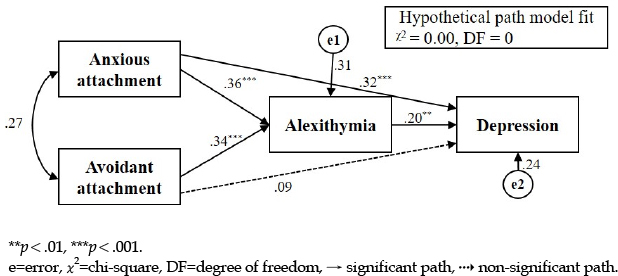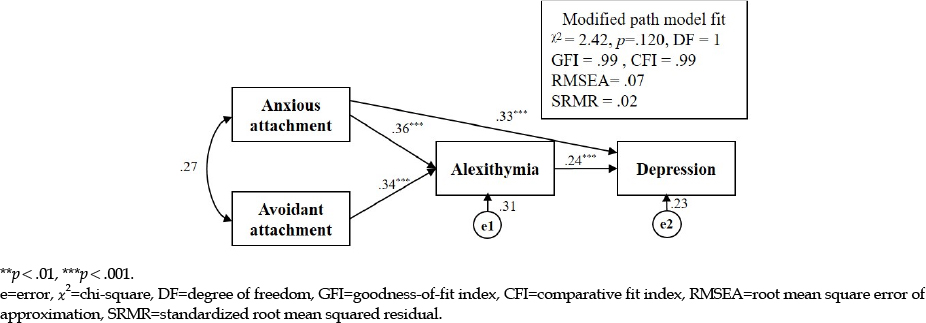J Korean Acad Psychiatr Ment Health Nurs.
2019 Jun;28(2):124-132. 10.12934/jkpmhn.2019.28.2.124.
The Mediating Effect of Alexithymia on the Relationship between Attachment and Depression in Early Adulthood
- Affiliations
-
- 1Doctoral Student, Graduate School, Division of Nursing Science, Ewha Womans University, Seoul, Korea.
- 2Associate Professor, College of Nursing, Ewha Womans University, Seoul, Korea. suksunkim@ewha.ac.kr
- KMID: 2451387
- DOI: http://doi.org/10.12934/jkpmhn.2019.28.2.124
Abstract
- PURPOSE
The purpose of this study was to examine the mediating effect of alexithmia on the relationship between attachment and depression in early adulthood.
METHODS
A convenience sample of 260 young adults responded to the survey. The collected data were analyzed using descriptive statistics, independent t-test, Pearson's correlation coefficients, and path analyses using bootstrapping.
RESULTS
The path analysis indicated that anxious attachment and alexithymia was positively related to depression, but there was not a significant relationship between avoidant attachment and depression. In a modified path model, alexithymia mediated the positive effects of anxious attachment and avoidant attachment on depression.
CONCLUSION
Our study findings suggest that early adults who have insecure attachments are vulnerable to alexithymia and depression. Targeted interventions to improve emotional expressive ability may reduce depression in early adulthood.
Keyword
Figure
Reference
-
1. Jang HS. Exploratory study for developmental task and beginning time of early adulthood. The Korean Journal of Developmental Psychology. 2008; 21(4):109–126.2. Ministry of Health and Welfare, Samsung Medical Center. The survey of mental disorders in Korea, 2016 [Internet]. Sejong: Ministry of Health and Welfare;2017. cited 2019 Jan 8. Available from: http://www.mohw.go.kr/react/jb/sjb030301vw.jsp.3. Girolamo G, Dagani J, Purcell R, Cocchi A, McGorry PD. Age of onset of mental disorders and use of mental health services: needs, opportunities and obstacles. Epidemiology and Psychiatric Sciences. 2012; 21(1):47–57. DOI: 10.1017/S2045796011000746.
Article4. Song JY, Baek JU, Kim JW. Development of a model for the detection and management of depression in young adult. National Hospital for Mental Health Academic Research Service Project Report. Seoul: Kyung-Hee University;2008. 11. cited 2019 Jan 24. Available from: http://www.ncmh.go.kr/kor/dep/depReportView.jsp?no=645&fno=84&depart=0&search_gubun=1&pg=5&search_item=0&search_content=&menu_cd=K_04_10_00_00_T0&category=report01.5. Zisook S, Lesser I, Stewart JW, Wisniewski SR, Balasubramani GK, Fava M, et al. Effect of age at onset on the course of major depressive disorder. The American Journal of Psychiatry. 2007; 164(10):1539–1546. DOI: 10.1176/appi.ajp.2007.06101757.
Article6. Ahn JH. Depression, suicide, and Korean society. Journal of the Korean Medical Association. 2012; 55(4):320–321. DOI: 10.5124/jkma.2012.55.4.320.
Article7. Choi S, Lee S, Matejkowski J, Baek YM. The relationships among depression, physical health conditions and healthcare expenditures for younger and older Americans. Journal of Mental Health. 2014; 23(3):140–145. DOI: 10.3109/09638237.2014.910643.
Article8. Bowlby J. A secure base: parent-child attachment and healthy human development. USA: Basic books;1988. p. 181.9. Shaver PR, Mikulincer M. Adult attachment strategies and the regulation of emotion. New York: Guilford Press;2007. p. 446–465.10. Mikulincer M, Shaver PR, Pereg D. Attachment theory and affect regulation: the dynamics, development, and cognitive Consequences of attachment-related strategies. Motivation and Emotion. 2003; 27(2):77–102. DOI: 10.1023/A:1024515519160.11. Fraley RC, Waller NG, Brennan KA. An item response theory analysis of self-report measures of adult attachment. Journal of Personality and Social Psychology. 2000; 78(2):350–365. DOI: 10.1037//0022-3514.78.2.350.
Article12. Aslam N. Attachment styles as a predictor of emotional expression among depressed and non depressed individuals. Journal of Behavioural Sciences. 2013; 23(1):102–117.13. Kim BJ, Oh KJ. Exploration of mediators between adult attachment and depression: discriminatory effect of affect regulation against social interaction anxiety. The Korean Journal of Counseling and Psychotherapy. 2013; 25(3):519–548.14. Jeon HK. The effect of anger expression as medium on the correlation between attachment and depression of college students. The Korea Journal of Youth Counseling. 2014; 22(1):173–199.15. Bagby RM, Parker JDA, Taylor GJ. The twenty-item Toronto Alexithymia Scale I: item selection and cross-validation of the factor structure. Journal of Psychosomatic Research. 1994; 38(1):23–32. DOI: 10.1016/0022-3999(94)90005-1.
Article16. Lee YH, Rim HD, Lee JY. Development & validation of a Korean version of the 20-item Toronto Alexithymia Scale (TAS-20K). Journal of Korean Neuropsychiatric Association. 1996; 35(4):888–899.17. Hemming L, Haddock G, Shaw J, Pratt D. Alexithymia and its associations with depression, suicidality and aggression: an overview of the literature. Frontiers in Psychiatry. 2019; 10:203. DOI: 10.3389/fpsyt.2019.00203.
Article18. Son SH, Jo H, Rim HD, Kim JH, Kim HW, Bae GY, et al. A comparative study on alexithymia in depressive, somatoform, anxiety, and psychotic disorders among Koreans. Psychiatry Investigation. 2012; 9(4):325–331. DOI: 10.4306/pi.2012.9.4.325.
Article19. Honkalampi K, Hintikka J, Tanskanen A, Lehtonen J, Viinamäki H. Depression is strongly associated with alexithymia in the general population. Journal of Psychosomatic Research. 2000; 48(1):99–104. DOI: 10.1016/S0022-3999(99)00083-5.
Article20. Kim SY. Foundation and extension of structural equation model. Seoul: Hakjisa;2016. p. 656.21. Kim SH. Adaptation of the Experiences in Close Relationships-Revised Scale into Korean: confirmatory factor analysis and item response theory approaches [master's thesis]. [Seoul]: Seoul National University;2004. 142.22. Radloff LS. The CES-D scale: a self-report depression scale for research in the general population. Applied Psychological Measurement. 1977; 1(3):385–401. DOI: 10.1177/014662167700100306.23. Cho MJ, Kim KH. The diagnostic validity of the CES-D (Korean version) in the assessment of DSM-III-R major depression. Journal of Korean Neuropsychiatric Association. 1993; 32(3):381–399.24. Cha JY, Moon HJ. The effects of alexithymia, burnout, and adult attachment on child disciplinary style of childcare teachers. Journal of Korean Home Management Association. 2013; 31(5):33–45. DOI: 10.7466/JKHMA.2013.31.5.033.
Article25. Stevens FL. Affect regulation styles in avoidant and anxious attachment. Individual Differences Research. 2014; 12(3):123–130.26. Choi WC, Kim NH, Choi SW, Jung IC. Preliminary study on the usefulness of psychological scale measurements in depression symptoms. Journal of Oriental Neuropsychiatry. 2013; 24(4):363–372. DOI: 10.7231/jon.2013.24.4.363.
Article27. Honkalampi K, Koivumaa-Honkanen H, Lehto SM, Hintikka J, Haatainen K, Rissanen T, et al. Is alexithymia a risk factor for major depression, personality disorder, or alcohol use disorders? a prospective population-based study. Journal of Psychosomatic Research. 2010; 68(3):269–273. DOI: 10.1016/j.jpsychores.2009.05.010.
Article28. Conrad R, Wegener I, Imbierowicz K, Liedtke R, Geiser F. Alexithymia, temperament and character as predictors of psychopathology in patients with major depression. Psychiatry Research. 2009; 165(1-2):137–144. DOI: 10.1016/j.psychres.2007.10.013.
Article29. McDonald HM, Sherman KA, Petocz P, Kangas M, Grant KA, Kasparian NA. Mindfulness and the experience of psychological distress: the mediating effects of emotion regulation and attachment anxiety. Mindfulness. 2016; 7(4):799–808. DOI: 10.1007/s12671-016-0517-9.
Article
- Full Text Links
- Actions
-
Cited
- CITED
-
- Close
- Share
- Similar articles
-
- The Relationship between Attachment Style, Alexithymia, Marital Satisfaction and Depressive Symptoms
- Relationship of Attachment Security, to Social Anxiety, and Depression in School-aged Children: The Mediating Effect of Self Competency
- The Mediating Effects of the Depression, Anxiety on the Relationship Between Temperament and Character and Maternal-Fetal Attachment in High-Risk Pregnant Women
- The Intervening Role of Alexithymia in the Relationship between Attachment Styles and Test Anxiety among Gifted High School Students
- The Influence of Parent and Peer Attachment in Adolescent's Suicidal Ideation: Mediating Effect of Depression and Anxiety



